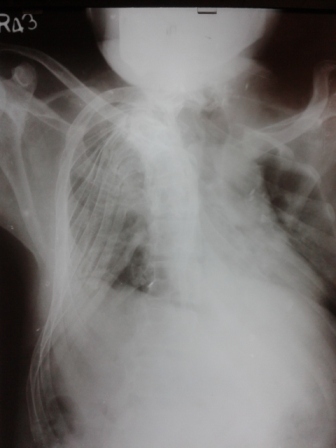Tapas Kumar Singh, MD, Yogita Dwivedi, MD, Trilok Chand, MD, Chakresh Jain, MD
Department of Anesthesiology, Sarojini Naidu Medical College, Agra-282002 (India); E-mail: singh.tapas1@gmail.com
Patients with deformed spine due to scoliosis, kyphoscoliosis, or arthritis (e.g. osteoarthritis, rheumatoid arthritis, and ankylosing spondylitis), pose practical challenges to the anesthesiologist in administration of successful subarachnoid block (SAB). Rotation of spine, limited articular mobility, obliteration of the interspinal spaces, and increased difficulty in positioning the patient, all add up to complicate success by conventional midline approach. We report a case of a patient with neurofibromatosis and severe kyphoscoliosis, where midline approach for SAB was not feasible and Taylor’s approach proved a useful alternative to conventional midline technique.
A 25 years old male presented for emergency above-knee-amputation for crush injury after road traffic accident. History and physical examination revealed that the patient suffered from neurofibromatosis type1 (Figure 1) during childhood with appearance of multiple skin nodules and progressively developed a scoliotic spine. Bedside pulmonary function tests revealed poor respiratory reserve. Chest x-ray (PA view) revealed scoliosis with crowding of ribs (Figure 2). Rest of the investigations and hemodynamic parameters were within normal limits. Because of the emergent nature of the surgery, the patient could not be evaluated thoroughly to rule out any syndromic association and a decision to administer SAB was taken.
In the operating room, standard monitors were attached and preloading with 750 ml of Ringer lactate solution was done. Lumbar puncture with 27 gauge quincke needle was attempted initially by a junior resident through midline approach but the aberrant anatomy of the kyphoscoliotic spine prevented successful location of subarachnoid place. A single attempt was taken by the senior resident who was well versed with the technique and had been performing SAB using Taylor’s approach regularly at L5-S1 interspace whereby the spinal needle was inserted in a cephalomedial direction through a skin wheel raised 1 cm medial and 1 cm caudal to the lowermost prominence of the posterior iliac spine. The needle was walked off the sacrum to enter the subarachnoid space. Free flow of CSF was obtained confirming successful location of proper needle placement and 7 mg of bupivacaine with 15 mcg fentanyl was injected in subarchnoid space to achieve spinal block upto T10 level. Surgery was completed uneventfully.
Taylor’s approach is a variation of the paramedian approach which is carried out at the L5-S1 interspace, the largest interlaminar interspace of the vertebral column which is least affected by osteoarthiritc, degenerative changes. Previously Jindal et al,1 Kumkum Gupta et al2 and M.Saraswat et al3 have successfully used this technique in kyphoscoliotic patients and have stressed on the necessity to teach this technique under supervision. As with any other acquired skill, the Taylor’s approach also requires repeated practice which should be rehearsed on normal spines before attempting on grossly deformed spine.

Figure 2: Chest x-ray PA view

Department of Anesthesiology, Sarojini Naidu Medical College, Agra-282002 (India); E-mail: singh.tapas1@gmail.com
Patients with deformed spine due to scoliosis, kyphoscoliosis, or arthritis (e.g. osteoarthritis, rheumatoid arthritis, and ankylosing spondylitis), pose practical challenges to the anesthesiologist in administration of successful subarachnoid block (SAB). Rotation of spine, limited articular mobility, obliteration of the interspinal spaces, and increased difficulty in positioning the patient, all add up to complicate success by conventional midline approach. We report a case of a patient with neurofibromatosis and severe kyphoscoliosis, where midline approach for SAB was not feasible and Taylor’s approach proved a useful alternative to conventional midline technique.
A 25 years old male presented for emergency above-knee-amputation for crush injury after road traffic accident. History and physical examination revealed that the patient suffered from neurofibromatosis type1 (Figure 1) during childhood with appearance of multiple skin nodules and progressively developed a scoliotic spine. Bedside pulmonary function tests revealed poor respiratory reserve. Chest x-ray (PA view) revealed scoliosis with crowding of ribs (Figure 2). Rest of the investigations and hemodynamic parameters were within normal limits. Because of the emergent nature of the surgery, the patient could not be evaluated thoroughly to rule out any syndromic association and a decision to administer SAB was taken.
In the operating room, standard monitors were attached and preloading with 750 ml of Ringer lactate solution was done. Lumbar puncture with 27 gauge quincke needle was attempted initially by a junior resident through midline approach but the aberrant anatomy of the kyphoscoliotic spine prevented successful location of subarachnoid place. A single attempt was taken by the senior resident who was well versed with the technique and had been performing SAB using Taylor’s approach regularly at L5-S1 interspace whereby the spinal needle was inserted in a cephalomedial direction through a skin wheel raised 1 cm medial and 1 cm caudal to the lowermost prominence of the posterior iliac spine. The needle was walked off the sacrum to enter the subarachnoid space. Free flow of CSF was obtained confirming successful location of proper needle placement and 7 mg of bupivacaine with 15 mcg fentanyl was injected in subarchnoid space to achieve spinal block upto T10 level. Surgery was completed uneventfully.
Taylor’s approach is a variation of the paramedian approach which is carried out at the L5-S1 interspace, the largest interlaminar interspace of the vertebral column which is least affected by osteoarthiritc, degenerative changes. Previously Jindal et al,1 Kumkum Gupta et al2 and M.Saraswat et al3 have successfully used this technique in kyphoscoliotic patients and have stressed on the necessity to teach this technique under supervision. As with any other acquired skill, the Taylor’s approach also requires repeated practice which should be rehearsed on normal spines before attempting on grossly deformed spine.
REFERENCES
- Jindal P, Chopra G, Chaudhary A, Rizvi AA, Sharma JP. Taylor’s approach in an ankylosing spondylitis patient posted for percutaneous nephrolithotomy. A challenge for anesthesiologists. Saudi J Anaesth 2009;3:87-90
- Gupta K , Rastogi B, Gupta PK, Rastogi A,Jain M,Singh VP. Subarachnoid block with Taylor’s approach for surgery of lower half of the body and lower limbs: A clinical teaching study. Anesthesia: Essays and Researches; 6:38-41
- M Saraswat, M Radhakrishnan. Spinal Anesthesia In A Patient With Kyphoscoliosis. The Internet Journal of Anesthesiology. 2001 Volume 6 Number 1.

Figure 2: Chest x-ray PA view
